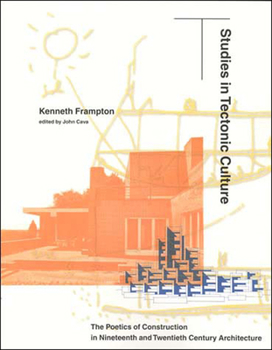Studies in Tectonic Culture: The Poetics of Construction in Nineteenth and Twentieth Century Architecture
Select Format
Select Condition 
Book Overview
Composed of ten essays and an epilogue that trace the history of contemporary form as an evolving poetic of structure and construction, the book's analytical framework rests on Frampton's close readings of key French and German, and English sources from the eighteenth century to the present. Kenneth Frampton's long-awaited follow-up to his classic A Critical History of Modern Architecture is certain to influence any future debate on...
Format:Paperback
Language:English
ISBN:0262561492
ISBN13:9780262561495
Release Date:October 2001
Publisher:MIT Press
Length:448 Pages
Weight:3.25 lbs.
Dimensions:0.9" x 8.6" x 10.9"
Age Range:18 years and up
Grade Range:Postsecondary and higher
Customer Reviews
4 ratings
Concrete Poetry
Published by Thriftbooks.com User , 16 years ago
Anyone who designs buildings will benefit from reading this book. It's no secret that many buildings today are at the same time technologically advanced and tectonically primitive, that despite their long-span, multi-zone, taut-skin gizmos they still look shoddy. If, as a non-architect, you suppose there is some kind of planned obsolescence that is designed into buildings as with cars, you are mistaken. Paradoxically, this is only the appearance of shoddyness--our structures could last longer than the pyramids, they only look as if they might fall down. The insightful and subtle critic and theorist Kenneth Frampton wrote this in 1995 to explain the discrepancy to architects. His subtitle is The Poetics of Construction, and that is what his book is about. If you wonder: what poetics? you might think of W.H. Auden's remark, 'when civilization is becoming monotonously the same all the world over...in poetry, at least, there cannot be an "International Style."' Frampton talks about a poetic formal dimension that transcends technology and materials. The tectonic culture of the title is the mastery of the craft of building, and it is easier understood when you can see the drawings and photographs that accompany the text. Frampton is himself a master in, amongst other things, making his point with architectural images you haven't seen before. Frampton has spent many years studying the tectonic culture of the great practitioners of modernism. Like a Sherlock Holmes of architectural history, he sees the significance of the smallest detail and how it can fit into the larger scheme. He puts this talent to great use in the six chapters where he analyses buildings by Wright, Mies, Auguste Perret, Louis Kahn, Utzon and Scarpa. The work of others is also considered: Foster, Herman Hertzberger, engineers like Boot's-of-Nottingham's designer Owen Williams and Pier Luigi Nervi, H.P. Berlage, Aalto, late le Corbusier, there are many more. He ends with Renzo Piano. He sees Piano's Building Workshop as an exemplary way to practise architecture, and though recently completed projects like the NY Times Building are missing (this came out twelve years ago, remember) there's no reason to think Frampton's changed his mind. Nevertheless the book could do with an update. Koolhaas, Gehry, and many other stars whose far reaching influence is spacial rather than about master craftsmanship in building, don't appear here; but what about Japan (there's only one reference to Ando and none to Ban)? Incidently, Frampton--remembering, probably, that when architects move on there is a tendency to throw out the baby with the bath water--notes that tectonic culture must be considered in addition to other things, like space, and not instead of them. Jeremy Hawker
work and think
Published by Thriftbooks.com User , 18 years ago
It might be arguable whether Kenneth Frampton is an excellent architectural theorist, but he is definitely one of the most critical analysists and knowlegeable historians. Frampton, in this book, opens a new window for us to look at and to think about architecture. He first defined the term 'tectonics' culture with the theory of Semper. Then he critically analyses the tectonic quality of some of the modernist masters' buildings (Mies, Kahn, Wright, Utzon etc). People might argue that studies architecture only by their tectonic quality reveals only partially of the architect's intent and this is why I think Frampton misunderstood Mies' intent. However, one could not disagree with Frampton's critical architectural analytical skill. One of the biggest problems of contemporary architecture theorists is lacking of professional knowledges and architectural analytical skills. This makes architecture theory as an over generalized conceptual debate. As a result, it ultimately delineates the 'professionalism' of architect: one either work or think. 'Studies in Tectonic culture' built a new bridge to save our professionalism from 'no-brainers'.
Read the Tectonics in Architecture
Published by Thriftbooks.com User , 20 years ago
I have read this book in 1996, and found it very useful for any architect who wants to further his knowledge of modern architecture. The insights of Mr. Frampton with his deep and wide knowledge of architecture makes this book a must have for any architect. It is a different point of view in the theory of architecture than the normal story telling book of Architectural history.
A must buy!
Published by Thriftbooks.com User , 20 years ago
The book contains black and white high resolution photos and architectural drawings. Frampton's text is well written, to the point, and downright interesting. A must buy for any serious architect!





